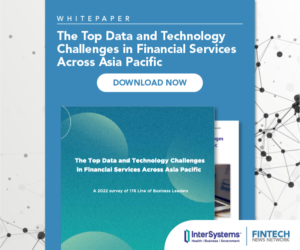The trade finance industry has been aspiring for greater digitalisation, striving to tap into potential benefits such as improved transparency, efficiency, risk mitigation and support for small and medium-sized enterprises (SMEs).
But despite some progress, advancements have been slow for the past few decades due to legal obstacles, the lack of standards, and the need for unifying technologies, a new paper by Deutsche Bank says.
The paper, titled “A Guide to Digital Trade Finance”, examines the progress that has been made so far, as well as what is still needed on the road ahead. The guide provides a practical toolkit for the industry, leveraging expert opinions from various stakeholders to explore the role of banks in digitalization initiatives, legal frameworks, international standards and innovative technologies.
Nimble progress
According to the report, banks have done a considerable amount to collectively unlock digital trade. This has been done by updating their own systems, and embracing cloud-based technologies to do so, but also by playing an active role in pilot projects, such as the we.trade platform, the Trade Information Network and Marco Polo.
But despite these efforts and high demand for digital trade finance, implementing new instruments to the trade finance market has been a complex endeavor, hindering widespread adoption of attempts to reinvent traditional processes.
In particular, the report notes that the widespread adoption of digital alternatives for mainstream trade finance documents has remained a major sticking point. This is despite the general consensus that the industry generates huge amounts of paper each year and that transparency throughout the transaction journey is poor.
The paper discusses the contrasting trajectories of digital payments and digital trade finance, noting that cross-border payments have achieved rapid digitalization and benefited from a horizontal solution like Swift GPI.
In contrast, digital trade finance lacks such a solution and often relies on specialized vertical solutions that address specific pain points. The report emphasizes the need for integrated digital solutions and the importance of standards and interoperability.
Opportunities of digital trade finance
The report highlights opportunities in digitalizing trade to address major challenges in the industry. It shares predictions from the International Chamber of Commerce (ICC) and the Boston Consulting Group (BCG), which estimate that trade digitization could boost trade revenues by up to 20%, cut processing times by 60%, and save global trade banks up to US$6 billion annually. In a separate study, the ICC also states that paperless trade could create US$267 billion worth of additional exports among G7 countries by 2026.
The report emphasizes some of the key benefits of the digitalization of trade finance including increased efficiency through the reduction of manual, paper-based processes and lower transaction costs.
Digitalizing trade also means that when supply chains are interrupted, the various parties can continue to share information, enabling more transparent communication in times of crisis. This can help mitigate value chain disruptions and allow stakeholders to avoid losses caused by inadequate documentation during supply chain interruptions.
Furthermore, digitization addresses fraud challenges prevalent in paper-based trade transactions by enabling documents to be sent securely and immediately to the relevant parties. This allows for real-time updates on payments and shipping statuses, enabling improved monitoring of transaction processes by various stakeholders.
Digital trade finance platforms also provide centralized hubs for documentation, communication, and approval processes. This centralization significantly expedites transaction times while simultaneously reducing the associated administrative overheads both for the provider of financing and the recipient.
Finally, digital trade finance means a shift from paper to electronic alternatives in trade processes, potentially reducing environmental footprints. The Economic and Social Commission for Asia and the Pacific (ESCAP) estimates up to an 86kg of CO2 reduction per end-to-end transaction when using digital rather than paper processes.
Fragmentation among key challenges
Despite these opportunities, several obstacles are hindering the development of digital trade. These challenges range from a longstanding reliance on paper to an increasingly fragmented technology landscape.
Firstly, the report notes that the dominance of paper is deeply rooted in the trade process, with paper documents having been used to facilitate trade for centuries. Alongside this long history, the fact that paper-based documents work and remain globally accepted has also fueled resistance to change.
The second challenge outlined is the lack of harmonization with different countries having different legislative systems. Also, there is no unified effort to unlock digital trade, which has led to the creation of multiple different systems, platforms and solutions that are owned and operated by separate vendors. This has served to fragment trade, creating a series of “digital islands” each with their own standards and procedures.
Finally, efforts to digitalize trade have been held back by the lack of clear direction. While the introduction of new providers, technologies and solutions has moved the conversation forward, it has also served to spread the attention of the industry, preventing projects from getting off the ground.
Key technologies
The report names technology as a fundamental driver of trade finance digitalization, highlighting application programming interfaces (APIs), optical character recognition (OCR) and distributed ledger technology (DLT) among the most promising innovations in trade finance.
APIs, a key technology that’s being used in the industry, enable systems to communicate with each other without human intervention, and serve as a way to exchange data quickly and securely. This ultimately allows financial institutions to integrate new products into existing systems at a low cost with minimal effort.
OCR, meanwhile, is a technology that converts printed text into machine encoded text, effectively digitizing paper documents. It allows users to electronically edit documents that were previously in print, while simultaneously removing the need for the documents to be stored physically.
Finally, DLT is heralded as one of the most transformative technologies in trade finance, making it possible for documentation to flow transparently yet securely among banks, trading companies and other network participants. It enhances trust, prevents fraud, and provides complete transparency by recording transactions immutably.
Featured image credit: Edited from freepik
- SEO Powered Content & PR Distribution. Get Amplified Today.
- PlatoData.Network Vertical Generative Ai. Empower Yourself. Access Here.
- PlatoAiStream. Web3 Intelligence. Knowledge Amplified. Access Here.
- PlatoESG. Carbon, CleanTech, Energy, Environment, Solar, Waste Management. Access Here.
- PlatoHealth. Biotech and Clinical Trials Intelligence. Access Here.
- Source: https://fintechnews.sg/84556/blockchaintradefinance/trade-finance-poised-for-digital-revolution-though-obstacles-remain/
- :has
- :is
- $UP
- 1
- 2026
- 250
- 300
- 7
- a
- accepted
- achieved
- active
- Additional
- address
- addresses
- administrative
- Adoption
- advancements
- ahead
- AI
- allow
- allows
- alongside
- also
- alternatives
- among
- amount
- amounts
- an
- and
- Annually
- APIs
- Application
- approval
- ARE
- AS
- asia
- aspiring
- associated
- At
- Attempts
- attention
- avoid
- back
- Bank
- Banks
- BCG
- BE
- been
- begin
- being
- benefits
- Billion
- boost
- boston
- Boston Consulting Group
- both
- but
- by
- CAN
- caps
- caused
- Centralization
- centralized
- centuries
- chain
- chains
- challenge
- challenges
- Chamber
- change
- character
- character recognition
- clear
- co2
- collectively
- Commerce
- commission
- communicate
- Communication
- Companies
- complete
- complex
- Consensus
- considerable
- consulting
- content
- continue
- contrast
- Conversation
- Cost
- Costs
- could
- countries
- create
- Creating
- creation
- credit
- crisis
- cross-border
- cross-border payments
- Cut
- data
- decades
- deeply
- Demand
- Despite
- Deutsche Bank
- Development
- different
- digital
- Digital Payments
- digital revolution
- digitalisation
- digitalization
- digitization
- digitizing
- direction
- discusses
- disruptions
- distributed
- Distributed Ledger
- distributed ledger technology
- Distributed Ledger Technology (DLT)
- DLT
- do
- documentation
- documents
- Dominance
- done
- driver
- due
- during
- each
- Economic
- edited
- effectively
- efficiency
- effort
- efforts
- Electronic
- electronically
- embracing
- emphasizes
- enable
- enabling
- end
- end-to-end
- endeavor
- Enhances
- enterprises
- environmental
- Examines
- exchange
- existing
- expedites
- expert
- explore
- exports
- facilitate
- fact
- far
- few
- finance
- financial
- Financial institutions
- financing
- fintech
- flow
- For
- form
- Forward
- fragmented
- frameworks
- fraud
- from
- fueled
- fundamental
- G7
- General
- generates
- getting
- Global
- global trade
- Globally
- greater
- Ground
- Group
- guide
- Have
- having
- Held
- help
- High
- highlighting
- highlights
- history
- Horizontal
- hottest
- HTML
- HTTPS
- hubs
- huge
- human
- icc
- image
- immediately
- implementing
- importance
- improved
- in
- Including
- increased
- increasingly
- industry
- information
- initiatives
- innovations
- innovative
- innovative technologies
- institutions
- instruments
- integrate
- integrated
- interfaces
- International
- Interoperability
- interrupted
- intervention
- into
- Introduction
- IT
- journey
- Key
- Lack
- lacks
- landscape
- Led
- Ledger
- Legal
- Legislative
- leveraging
- like
- Long
- longstanding
- losses
- Low
- lower
- machine
- made
- mailchimp
- Mainstream
- major
- Making
- manual
- Marco
- Market
- means
- Meanwhile
- minimal
- Mitigate
- mitigation
- monitoring
- Month
- more
- most
- moved
- multiple
- names
- Need
- needed
- network
- New
- new products
- news
- no
- Notes
- noting
- obstacles
- OCR
- of
- off
- often
- on
- once
- ONE
- operated
- Opinions
- opportunities
- optical
- optical character recognition
- Other
- outlined
- own
- owned
- Pacific
- Pain
- Pain points
- Paper
- paper-based
- participants
- particular
- parties
- past
- payments
- per
- Physically
- pilot
- Pilot projects
- platform
- Platforms
- plato
- Plato Data Intelligence
- PlatoData
- playing
- Point
- points
- poised
- poor
- possible
- potential
- potentially
- Practical
- Predictions
- prevalent
- preventing
- prevents
- previously
- procedures
- process
- processes
- processing
- Products
- Programming
- Progress
- projects
- promising
- provide
- provider
- providers
- provides
- quickly
- range
- rapid
- rather
- real-time
- recognition
- recording
- reducing
- reduction
- reinvent
- relevant
- reliance
- remain
- remained
- removing
- report
- Resistance
- revenues
- Revolution
- Risk
- Risk Mitigation
- road
- Role
- rooted
- Save
- says
- Second
- securely
- sent
- separate
- Series
- serve
- served
- several
- Share
- share information
- Shares
- shift
- Shipping
- significantly
- simultaneously
- Singapore
- slow
- small
- SMEs
- So
- so Far
- Social
- solution
- Solutions
- some
- specialized
- specific
- spread
- stakeholders
- standards
- sticking
- Still
- stored
- striving
- Study
- such
- supply
- supply chain
- Supply chains
- support
- SWIFT
- Systems
- Tap
- Technologies
- Technology
- text
- than
- that
- The
- their
- There.
- These
- this
- though?
- Through
- throughout
- times
- to
- toolkit
- trade
- Trade Finance
- Trading
- traditional
- transaction
- transaction costs
- Transactions
- transformative
- Transparency
- transparent
- transparently
- Trust
- Ultimately
- unified
- unlock
- Updates
- updating
- used
- users
- using
- value
- various
- vendors
- vertical
- Way..
- we
- WELL
- were
- What
- What is
- when
- which
- while
- widespread
- with
- without
- Work
- worth
- year
- yet
- Your
- zephyrnet













